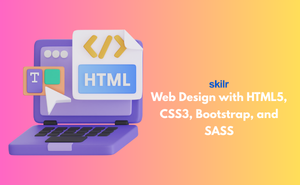👇 CELEBRATE CLOUD SECURITY DAY 👇
00
HOURS
00
MINUTES
00
SECONDS

The certification in Web Design with HTML5, CSS3, Bootstrap, and SASS equips learners with the knowledge to build stylish, responsive, and modern websites. HTML5 defines the content and structure, CSS3 enhances layouts with advanced design effects, Bootstrap simplifies the process of making mobile-ready websites, and SASS provides a more efficient way to manage and organize styling.
This skill set enables learners to design sites that not only look appealing but also deliver smooth user experiences. From personal portfolios to business websites, these tools give developers the ability to create designs that adapt to all screen sizes while maintaining professional quality. It’s the perfect entry into front-end web development and design.
This exam is ideal for:
Industry-endorsed certificates to strengthen your career profile.
Start learning immediately with digital materials, no delays.
Practice until you’re fully confident, at no additional charge.
Study anytime, anywhere, on laptop, tablet, or smartphone.
Courses and practice exams developed by qualified professionals.
Support available round the clock whenever you need help.
Easy-to-follow content with practice exams and assessments.
Join a global community of professionals advancing their skills.
It’s the process of creating modern, responsive, and visually appealing websites using these technologies.
No, basic computer knowledge is enough; coding will be introduced step by step.
It structures the content and layout of web pages.
CSS3 adds advanced features like animations, transitions, and grid layouts.
It helps in building responsive, mobile-friendly websites quickly.
SASS is a CSS preprocessor that makes writing and managing CSS more efficient.
Yes, it’s designed for beginners as well as intermediate learners.
Web designers, frontend developers, students, freelancers, and entrepreneurs.
While drag-and-drop tools exist, coding with these technologies gives more control and professional results.
Yes, responsive design with Bootstrap and CSS3 is a major focus.